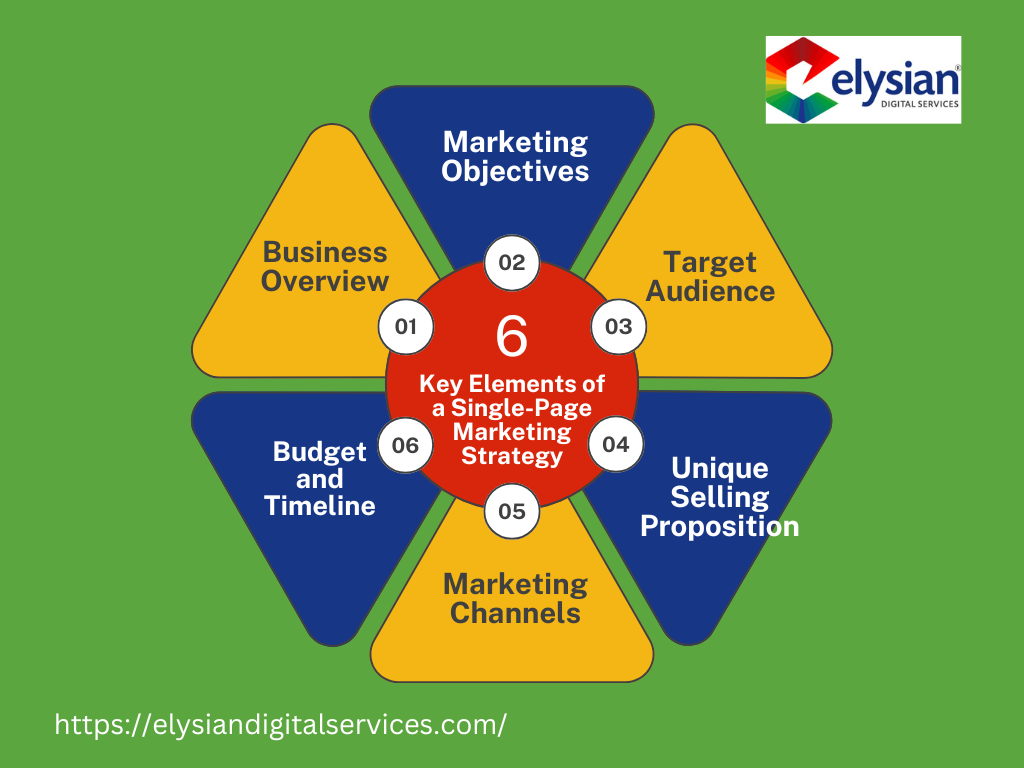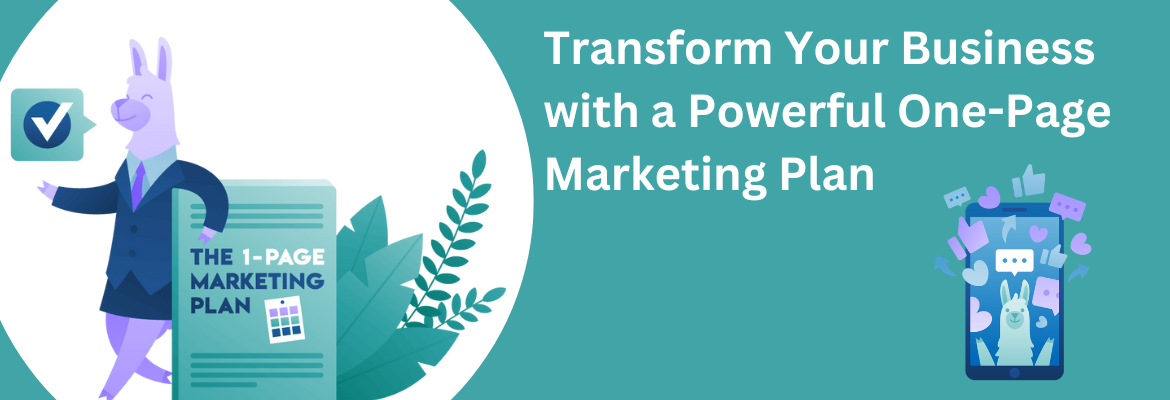Table of Contents
ToggleHow a One-Page Marketing Plan Can Transform Your Business Strategy?
Ever feel like your marketing strategy is all over the place? Too many moving parts, too much guesswork sound familiar? That’s where the one-page marketing plan comes in. Imagine boiling down your entire strategy onto a single page. It might sound too good to be true, but trust me, this game-changing approach can help you focus, save time, and stay on track.
In this post, we’ll explore how creating a marketing plan on a page can transform your business strategy, what elements you need to include, and how to make your business page a powerful marketing tool.
What Is a One-Page Marketing Plan and Why Do You Need It?
A one-page marketing plan is a brief, easy-to-follow guide for your business’s marketing strategy. As the name suggests, it fits all key information on a single page, making it simple and effective. Traditional marketing plans can be lengthy, complex, and often end up ignored. A one-page plan keeps things clear and actionable. Here’s why it matters:
Why You Need It
- Simplifies the Process
Crafting a traditional marketing plan can be time-consuming and overwhelming. A one-page format simplifies the process and helps you focus on what really matters. - Promotes Agility and Adaptability
Business environments change quickly. This type of plan makes it easier to pivot your strategy when needed without rewriting a long document. - Ensures Focus
Having a concise plan keeps your team aligned with your marketing goals. It provides a clear direction and eliminates distractions. - Easy to Update
Since it’s short and to the point, you can update it quickly as new goals arise or market conditions change. - Improves Collaboration
A one-page plan is easy to share across teams, ensuring everyone understands the strategy and works together effectively.
Why It’s a Game-Changer
- Clarity: Focuses on the essentials without unnecessary details.
- Alignment: Keeps the entire team on the same page.
- Simplicity: Quick to create, update, and share.
In today’s fast-paced business environment, a one-page marketing plan is a powerful tool. It saves time, reduces complexity, and keeps your business focused on achieving its marketing objectives.
What Are the Benefits of a One-Page Marketing Plan?
A one-page marketing plan offers numerous advantages, helping businesses streamline efforts and adapt quickly to changing market trends. Let’s explore the key benefits:
1. Saves Time and Effort
Creating a comprehensive marketing strategy often takes weeks of planning and writing. A one-page marketing plan simplifies this process significantly. Since it focuses only on the essentials, you’ll save time while ensuring that all critical elements are covered.
- No need to draft extensive documents.
- Helps you allocate time to more strategic tasks.
- Reduces overwhelm with a concise, actionable framework.
2. Better Focus on Priorities
A compact marketing plan forces you to concentrate on what truly matters. When your goals, tactics, and strategies are summarized on one page, it’s easier to stay focused on top priorities.
- Clearly define your business objectives.
- Avoid distractions by eliminating unnecessary details.
- Improve decision-making with a simplified overview.
3. Quick and Easy Adjustments
The marketing landscape is constantly evolving, and flexibility is essential for success. With a one-page plan, you can adapt quickly without wading through a lengthy document.
- Make changes effortlessly to keep up with trends.
- Stay responsive to new opportunities or challenges.
- Keep your plan fresh and relevant with minimal effort.
4. Improves Communication
Sharing a detailed marketing strategy with your team or stakeholders can be time-consuming and prone to misinterpretation. A one-page marketing plan makes communication much simpler.
- Ensures everyone understands the core strategy.
- Enhances team alignment and collaboration.
- Easy to share and present during meetings.
5. Increases Accountability
Condensing your plan to one page ensures clarity on roles, goals, and timelines.
- Everyone knows what’s expected of them.
- Simplifies performance tracking and progress reviews.
- Promotes greater accountability across the team.
In short, a one-page marketing plan is an efficient tool that saves time, helps maintain focus, and makes it easy to adapt to changes. Its simplicity enhances communication and collaboration, ensuring your team stays aligned with your business goals.
Key Elements of a Single-Page Marketing Strategy

Ready to create your one-page marketing plan? Here’s what you need to include:
1. Business Overview
Start with a brief description of your business, target audience, and key products or services. This sets the foundation for the rest of your plan.
Example:
- Business: ABC Marketing Solutions
- Target Audience: Small business owners in the tech industry
- Services: Digital marketing, SEO, and content creation
2. Marketing Objectives
Set clear, measurable goals. What do you want to achieve? Be specific and realistic.
Examples:
- Increase website traffic by 30% in six months
- Generate 50 new leads per month
- Boost social media engagement by 20%
3. Target Audience
Describe your ideal customer. Knowing your audience helps you tailor your marketing efforts for maximum impact.
Ask yourself:
- What problems do they face?
- What solutions are they looking for?
- Where do they spend their time online?
4. Unique Selling Proposition (USP)
What sets your business apart from the competition? Your USP should be short, compelling, and memorable.
5. Marketing Channels
List the key platforms and tactics you’ll use to reach your audience. These might include:
- Social Media: Facebook, Instagram, LinkedIn
- Email Marketing: Monthly newsletters, promotional emails
- Content Marketing: Blogs, videos, eBooks
- SEO: Optimize your business page and website for search engines
6. Budget and Timeline
Outline your marketing budget and key milestones. This will help you stay on track and avoid overspending.
How to Make a Business Page Work for You
A business page whether it’s on your website, social media, or a dedicated landing page plays a crucial role in your marketing strategy. Think of it as the face of your business online.
Tips for an Effective Business Page:
- Keep it clear and concise: No one likes to read endless paragraphs.
- Focus on your audience: Highlight how your services solve their problems.
- Add a call to action: Encourage visitors to take the next step (e.g., contact you, download a resource, or book a consultation).
- Optimize for SEO: Use keywords like “marketing business plan” and “promoting business” to improve search rankings.
Promoting Your Business with a One-Page Marketing Plan
Your one-page marketing strategy isn’t just a document it’s a living, breathing tool that guides your promotional efforts. Here’s how to use it effectively:
- Review and Update Regularly: Stay on top of trends and adjust your plan as needed.
- Share It with Your Team: Keep everyone aligned and working toward the same goals.
- Leverage Multiple Channels: Don’t rely on just one platform use a mix of social media, email, and content marketing.
Conclusion: Start Small, Think Big
A one-page marketing plan is the perfect tool to simplify your business strategy and stay laser-focused on what matters most. It’s easy to create, simple to update, and powerful enough to transform how you promote your business.
So, why complicate things? Get started today and watch your strategy fall into place, one page at a time.
Ready to Create Your One-Page Marketing Plan?
It’s time to take control of your marketing strategy. Map it out on a single page, stay focused, and drive your business forward. Your next step? Make a business page that works for you and watch the magic happen.
FAQs
Q1: What is a one-page marketing plan?
A one-page marketing plan is a simplified version of a traditional marketing strategy. It condenses your business goals, target audience, marketing tactics, and key objectives onto a single page for easy reference and quick updates.
Q2: Why should I use a one-page marketing plan for my business?
It saves time, improves focus, and allows for quick adjustments. A one-page plan helps you stay organized, prioritize your efforts, and ensure your team is aligned with your business goals without overwhelming details.
Q3: What are the key elements of a one-page marketing strategy?
A one-page marketing strategy typically includes your business overview, marketing objectives, target audience, unique selling proposition (USP), marketing channels, budget, and timeline.
Q4: How does a one-page marketing plan help promote my business?
It provides a clear roadmap for promoting your business, ensuring consistent messaging across marketing channels. It also helps you stay agile and adapt your strategy based on market trends.
Q5: How can I create an effective business page as part of my marketing plan?
Focus on clarity, audience needs, and strong calls to action. Optimize for SEO by using relevant keywords, keep the design user-friendly, and ensure it highlights your unique selling points and services.
